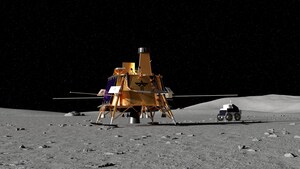WASHINGTON, April 25, 2017 /PRNewswire-USNewswire/ -- NASA successfully launched its football-stadium-sized, heavy-lift super pressure balloon (SPB) from Wanaka, New Zealand, at 10:50 a.m. Tuesday, April 25 (6:50 p.m. April 24 in U.S. Eastern Time), on a mission designed to run 100 or more days floating at 110,000 feet (33.5 km) about the globe in the southern hemisphere's mid-latitude band.
"Following our 2015 and 2016 New Zealand missions, we've learned key lessons on the balloon design that have gone into perfecting the technology for this year's flight," said Debbie Fairbrother, NASA's Balloon Program Office chief. "I'm very proud of the team that delivered us to this point and I'm hopeful that third time's the charm for realizing 100 days of flight."
While validating the super pressure balloon technology is the main flight objective, the International Extreme Universe Space Observatory on a Super Pressure Balloon (EUSO-SPB) payload is flying as a mission of opportunity. Also flying on the payload is a poppy in commemoration of Anzac Day, a national day of remembrance in New Zealand and Australia similar in spirit to the U.S. observance of Memorial Day.
EUSO-SPB's objective is to detect ultra-high energy cosmic rays from beyond our galaxy as they penetrate the Earth's atmosphere. As these high-energy particles enter the atmosphere, they interact with nitrogen molecules in the air and create a UV fluorescence light. From its high-altitude vantage point, EUSO-SPB will look downward observing a broad swathe of the Earth's atmosphere to detect the UV fluorescence from these deep space cosmic rays coming in from above.
"EUSO-SPB is now searching for the most energetic cosmic particles ever observed," said Angela V. Olinto, professor at the University of Chicago and principal investigator of the project. "The origin of these particles is a great mystery that our pioneering mission will help to solve. Do they come from massive black holes at the center of galaxies? Tiny, fast-spinning pulsars? Or somewhere else?"
"The international science team is very excited to see our cosmic ray fluorescence detector lifted to suborbital space by this remarkable balloon and departing on this global journey," said Lawrence Wiencke, professor at the Colorado School of Mines and deputy principal investigator. "This balloon will give us a great view, and we are hoping for a record flight. We would especially like to thank the NASA and Columbia Scientific Balloon Facility teams for their patience, hard work, and extensive expertise that made this launch successful."
At a relatively low cost, NASA's heavy-lift balloons have been critical launch vehicles for testing and validating new technologies and science instruments to assure mission success for costlier, higher-risk follow-on spaceflight missions, said Fairbrother. Once the technology is validated, the ultimate goal of the EUSO project is to fly from an even higher altitude on the International Space Station to observe a greater atmospheric area for detecting high-energy cosmic rays.
"We are proud to once again support NASA's scientific balloon program by demonstrating the experience and dedication needed to execute scientific balloon operations," said John Pullen, Vice President and General Manager, Technical Services Division of Orbital ATK's Space Systems Group. "The NASA/Orbital ATK team continues to deliver affordable and reliable long duration balloon flights across the world from Antarctica to New Zealand to Palestine, Texas home of the Columbia Scientific Balloon Facility. Our flexibility and history of success allow us to launch a variety of balloons that provide critical scientific data for new technologies and discoveries no matter the location."
The 18.8-million-cubic-foot (532,000-cubic-meter) Super Pressure Balloon lifted off from NASA's new launch pad adjacent to Wanaka Airport carrying a suspended payload of 5,500 pounds (2,495 kilograms). The new pad along with a recently established 10-year lease with Queenstown Airport Corporation are key developments for enhancing NASA's mid-latitude, long-duration balloon flight operations in New Zealand. According to Fairbrother, future investments include a payload processing facility on-site.
"It's been a huge privilege and honor to have the NASA and SPB team back again for a third year in Wanaka," said Ralph Fegan, Wanaka Airport operations manager. "The team here at Wanaka and Queenstown Airports are excited to see what the next 10 years bring as the relationship between us grows."
As the balloon travels around the Earth, it may be visible from the ground, particularly at sunrise and sunset, to those who live in the southern hemisphere's mid-latitudes, such as Argentina and South Africa. Anyone may track the progress of the flight, which includes a map showing the balloon's real-time location, at:
http://www.csbf.nasa.gov/newzealand/wanaka.htm
NASA's Wallops Flight Facility in Virginia manages the agency's scientific balloon flight program with 10 to 15 flights each year from launch sites worldwide. Orbital ATK, which operates NASA's Columbia Scientific Balloon Facility in Palestine, Texas, provides mission planning, engineering services and field operations for NASA's scientific balloon program. The CSBF team has launched more than 1,700 scientific balloons in the over 35 years of operation.
For more information on the balloon program, visit: http://www.nasa.gov/scientificballoons
For more information on the EUSO-SPB mission, visit: http://astroserve.mines.edu/euso_spb/2017-spb.html
SOURCE NASA
Related Links
WANT YOUR COMPANY'S NEWS FEATURED ON PRNEWSWIRE.COM?
Newsrooms &
Influencers
Digital Media
Outlets
Journalists
Opted In



Share this article